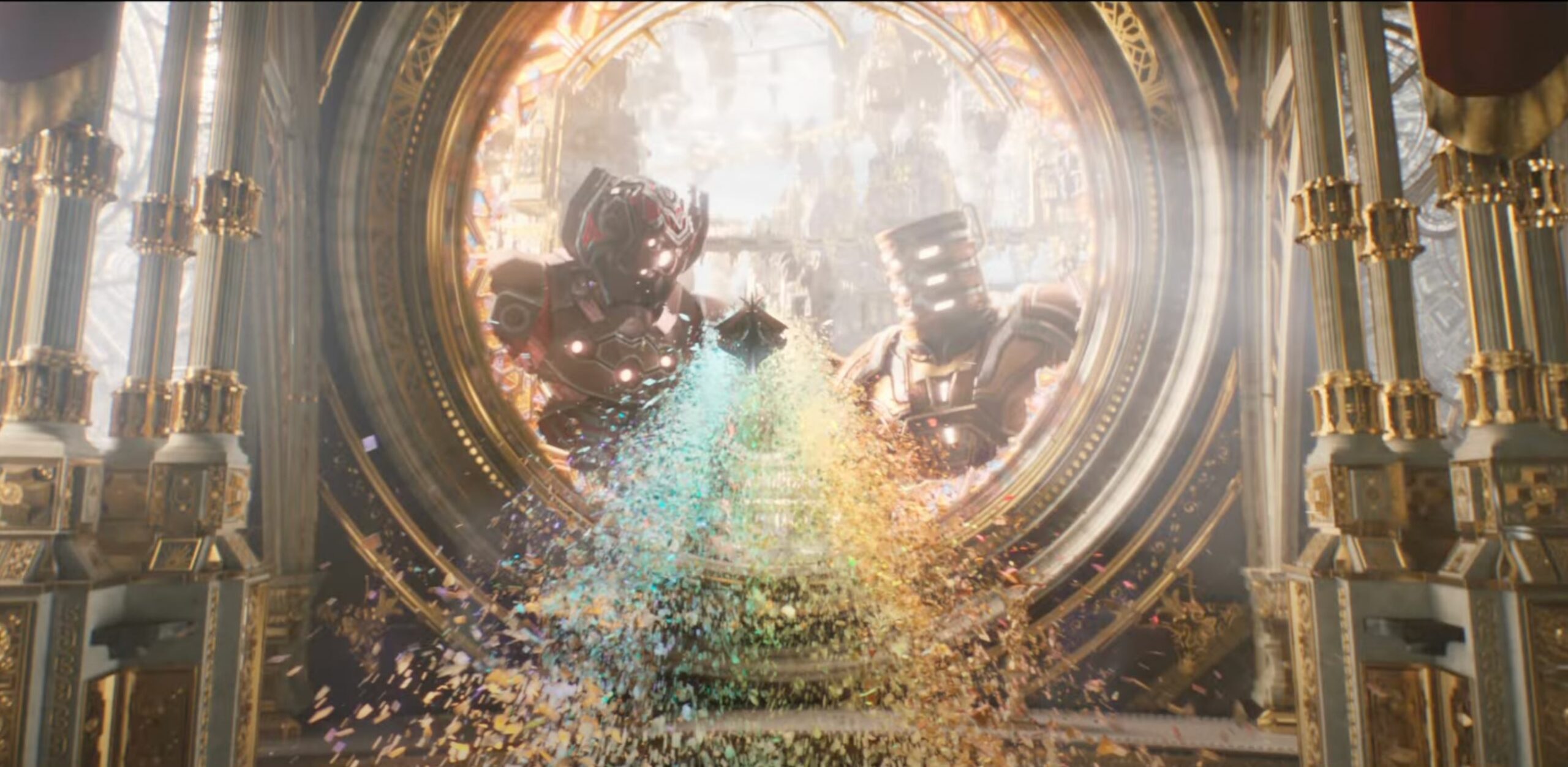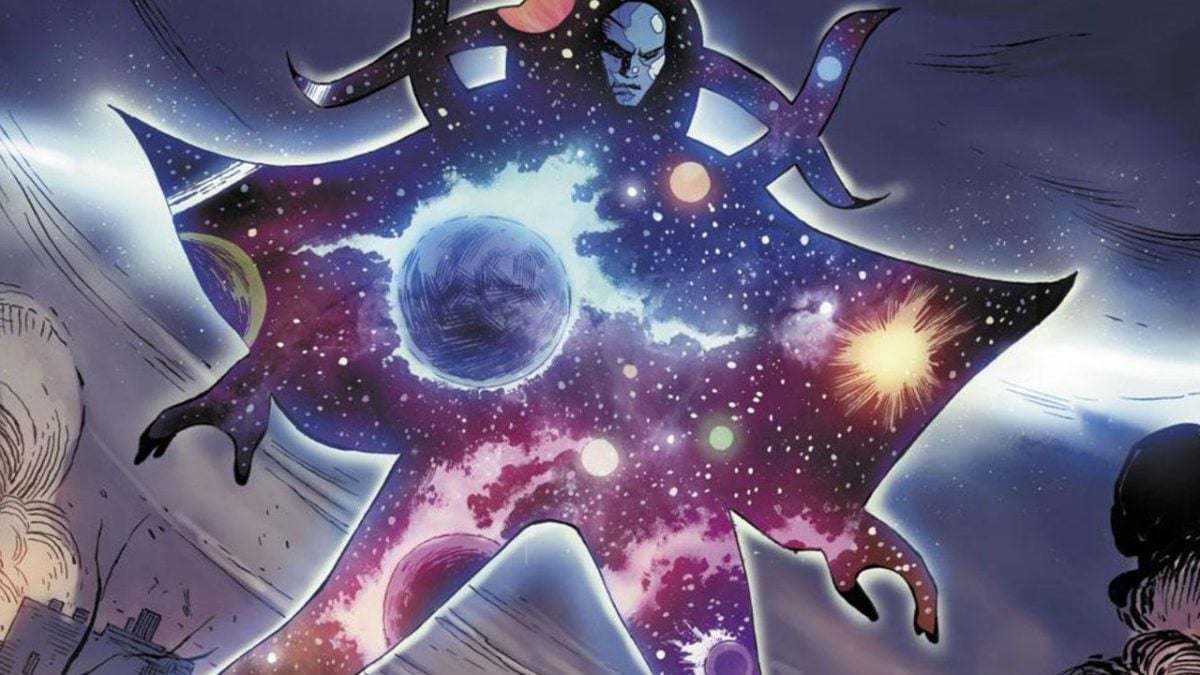*This article contains spoilers for ‘Thor: Love and Thunder’ and ‘Doctor Strange in the Multiverse of Madness’*
Thor: Love and Thunder expands the cosmology of the Marvel Cinematic Universe, including new pantheons of gods and even higher beings.
Eternity is an enigmatic figure in the film, in fact, we’re not sure we even meet him in any conventional sense. In the opening and closing acts, we see the figure as a statue, an open face divided in two by shadow. When the Bifrost is opened, and Gorr, Thor, and Jane discover Eternity, it’s a powerful and peaceful image. In the serene and shallow water at the center of the universe sits a silhouette of a figure in which we see the whole of the universe — or perhaps another. Eternity is less a protagonist than the goal of Thor’s fourth solo outing.
The movie sets several potential reasons for characters to reach Eternity. Thor’s loss, Jane’s survival, Gorr’s ultimate wish to eliminate all gods — any one of these could be solved at the center of the universe. As the legend goes, the first to meet Eternity will have their wish granted.
It makes you wonder why Thanos didn’t take a shortcut there instead of embarking on his sprawling quest to gather the Infinity Stones. Now we know there is an all-powerful creature at the universe’s center that could enact Thanos’s Snap without the need of the Infinity Gauntlet. Should the heroes of the MCU be worried? Is Eternity the new Thanos?
Getting cosmic

Eternity is one of Marvel’s Cosmic Entities, higher than gods and Celestials. Along with Entropy, Infinity, and Death, Eternity created the Infinity Stones. A dysfunctional family dating from at least the dawn of time, they’ve already played a significant role in the Marvel Cinematic Universe (MCU).
It’s no wonder Eternity has such a distinctive look. Possibly even predating the big bang, he has an unlimited ability to shape reality and know everything that has and is happening. Eternity, naturally, is immune from time and sits very near the top of the MCU power list. Only the Living Tribunal — glimpsed as statues and through artifacts in Doctor Strange in the Multiverse of Madness and Loki — is more powerful.
As we see in Thor: Love and Thunder, Eternity will grant a wish without limits or small print, and he’s happy to add a little extra. Eternity not only resurrects Gorr’s daughter Love but gives her the powers of a god.
Does that make Eternity a threat?
Eternity in Marvel Comics

The Cosmic Entities of the MCU were tied into the creation of the Infinity Stones as far back as Phase 2’s Guardians of the Galaxy.
In Marvel Comics, entities sit at the top of a broad pantheon of cosmic beings, including Celestials, as explored in Eternals, and Watchers, as seen in What If..? We’re yet to see the full range of these beings in the MCU and how they fit together, although they are slowly being drawn together.
In the comics, Eternity maintains the balance of the universe as the personification of time, just as his sister Infinity is space. Between them hangs the sentience of the universe, so on one level, if it wasn’t for these extraordinary cosmic beings, neither we of the MCU would exist. While some higher astral entities like Death have to take an active role in the affairs of the universe, Eternity is more aloof — as shown by the significant effort it takes to reach him in Thor: Love and Thunder.
Understandably, many heroes have a vested interest in keeping Eternity in existence and the being’s incredible powers away from the likes of Gorr. Eternity’s power makes him a target for some and something to be protected for others. In the comics, Doctor Strange’s enemy, the demon-lord Nightmare, once attempted to bring Eternity under his will, forcing the Sorcerer Supreme to intervene. Eternity may be oblivious to most of the lower lifeforms in the universe. Still, they have been able to reason with him to correct mistakes in reality. He has also shown awareness to sacrifice parts of himself to stop evil forces from unbalancing the universe or shaping reality to their twisted aims.
Eternity is unlikely to be a big bad of any future Marvel phase under his own accord. The plots of beings like Thanos or Kang the Conqueror are too small to contemplate unless they threaten the universe’s existence. That’s not to say that Eternity won’t have a significant role to play as the MCU expands its cosmic ambitions and more villains target his incredible power.
Eternity’s Future in the MCU

As of Thor: Love and Thunder, the threat of Eternity’s first wish is out the way — and the universe is lucky to have fresh new superhero Love as a result. The MCU has also resolved the story arc of the Infinity Stones and Infinity Gauntlet without involving cosmic entities – unlike the original comic arcs.
The next Thanos of the MCU is expected to be Kang the Conqueror, who was first met in one guise at the conclusion of Loki and is likely to appear in movie theaters during Phase 4 in Ant-Man and the Wasp: Quantumania. It’s probably no coincidence we’re learning more about these higher cosmic beings at the same time as the variants of Kang are being revealed.
Most intriguing is Eternity’s connection to some anticipated cosmic threats. The arrival of Reed Richards, or a variant at least, in Doctor Strange in the Multiverse of Madness, signals the arrival of those new threats with all the anticipation of the Silver Surfer appearing in the sky.
The Surfer is the traditional Herald of Galactus, announcing the arrival of his master — a vast cosmic entity that consumes planets to survive, as first introduced in the pages of Fantastic Four in March 1966. Galactus was developed to be the final survivor of the universe before ours, and this enormous threat has subsequently been an enemy and subject of major Marvel storylines. Galactus is a fascinating explanation of what it means to be a villain and the indifference of high-beings, but still consistently ranks as one of comics’ greatest bad guys.
In the comics, Eternity and Galactus have history. Eternity was once called to defend Reed Richards after the leader of the Fantastic Four revived Galactus and was held to account by the world-eater’s survivors. Eternity’s chilling contribution was a testament that Galactus plays a role in the balance of the universe and the continuity of the Marvel Multiverse.
Slowly and surely, the MCU is pulling together Marvel Comics’ wealth of cosmic characters, but as Eternity suggests, there’s no rush.

